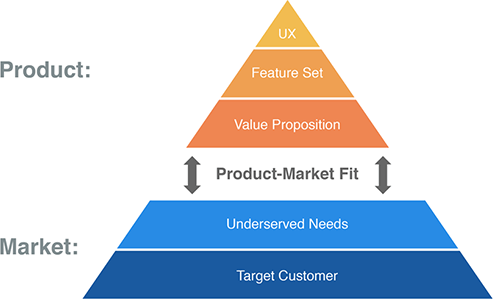Product-Market Fit
Product ideas may fail for many different reasons — but lack of market needs is by far the most important one. To avoid this, product-market fit is the first thing to achieve with any new product.
What is Product-Market Fit?
The term product/market fit describes ‘the moment when a startup finally finds a widespread set of customers that resonate with its product’.
Eric Ries | 12 Things About Product-Market Fit
With respect to the Four Key Risks of Product Management, it all starts with value for the customer – but not on the level of singular features or capabilities but instead for the entire product.
However, as already mentioned earlier, after customer value has been confirmed, it is essential that appropriate strategies for Marketing and Sales are in place and the product can be built, sold, distributed, and operated in a profitable manner. Only then have we achieved PMF.
Why is Product-Market Fit Important?
Before PMF has been confirmed, it is unclear whether enough customers are willing to use, and pay for, a product. As it turns out, this is the #1 reason for startups to fail.
And while this gap still exists, any investment into other objectives, such as extending the feature set, up-selling to existing customers, or growth is doomed for failure and might even hinder in finding true PMF.
When a great team meets a lousy market, market wins. When a lousy team meets a great market, market wins. When a great team meets a great market, something special happens.
Andy Rachleff | 12 Things About Product-Market Fit
How to Determine Product-Market Fit?
There is no single metric or observation that will clearly tell whether a startup has achieved PMF. Rather, a number of signals serve as indicators:
- Are customers involved in testing indicating they would use the product? Even switch from another solution?
- Do users involved in testing get hooked on the actual value proposition and competitive advantages?
- When customers rejected similar solutions before, are they willing to accept yours?
- When you already have built-in metrics, how do these compare to competitive offerings?
- Would users talk about your product and even recommend it to others via word of mouth?
Further Reading

12 Things About Product-Market Fit
The product/market fit (PMF) concept was developed and named by Andy Rachleff. The core of Rachleff’s idea for PMF was based on his analysis of the investing style of the pioneering venture capitalist and Sequoia founder Don Valentine.

Product-Market Fit
According to entrepreneur and investor Marc Andreesen, who is often credited with developing the concept, product-market fit means finding a good market with a product capable of satisfying that market.

A How-To Guide to Product-Market Fit
Start with defining the market, not the product.


